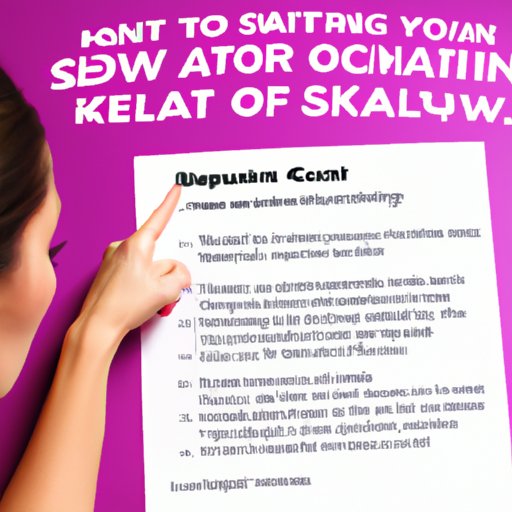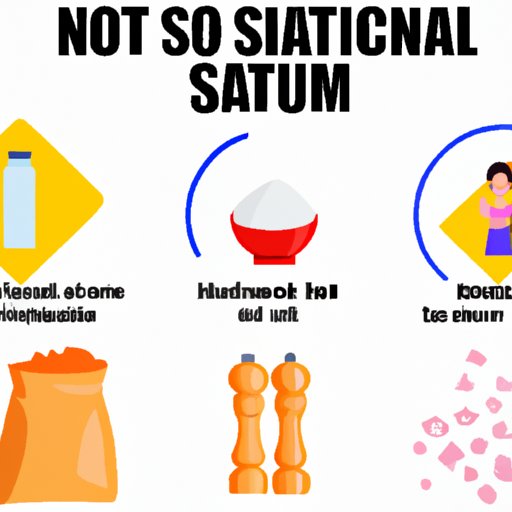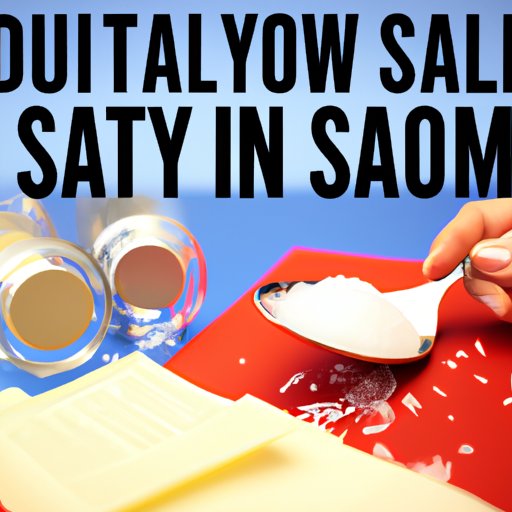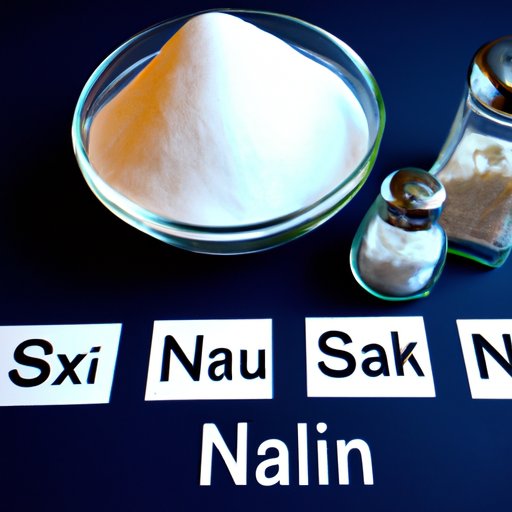Introduction
Sodium is an essential mineral that is important for many bodily functions, including maintaining fluid balance and regulating nerve and muscle activity. But too much sodium can have a negative impact on health, leading to high blood pressure, stroke, and other health issues. So how much sodium a day is healthy? In this article, we’ll explore the pros and cons of eating too much sodium, the recommended daily sodium intake, and the benefits of eating a low-sodium diet.
The Pros and Cons of Eating Too Much Sodium: How Much is Too Much?
The World Health Organization recommends that adults consume no more than 2,000 mg of sodium per day. However, some studies suggest that even this amount may be too high for optimal health. The American Heart Association (AHA) recommends that adults consume no more than 1,500 mg of sodium per day, while the American Medical Association (AMA) recommends 1,500 to 2,400 mg per day.
Eating too much sodium can lead to a number of health problems, including high blood pressure, stroke, heart attack, and kidney disease. Excessive sodium intake can also cause water retention, which can lead to bloating, swelling, and weight gain. On the other hand, eating too little sodium can lead to fatigue, weakness, dizziness, and nausea.
How to Balance Your Sodium Intake for Optimal Health
If you’re trying to reduce your sodium intake, there are several steps you can take to make sure you’re getting the right amount of sodium each day. Start by cutting back on processed foods, which tend to be high in sodium. Choose fresh or frozen fruits and vegetables instead of canned or packaged varieties. Avoid adding extra salt to your food when cooking or at the table. Try experimenting with herbs and spices to add flavor without the added sodium.
When shopping for groceries, read nutrition labels carefully. Look for products with lower sodium content, and opt for those that contain less than 140 mg of sodium per serving. When dining out, ask about ingredients and cooking methods – restaurants often use more salt than necessary. And when ordering takeout, avoid items that are fried, breaded, or heavily salted.
Finally, try substituting salt with other flavors. Herbs, garlic, onion, and citrus juice can all add flavor without the added sodium. Vinegars, mustards, and hot sauces are also great alternatives to traditional seasonings. With a little experimentation, you can find a variety of flavorful options that don’t require added salt.

What to Know About the Recommended Daily Sodium Intake
The recommended daily sodium intake varies depending on age, activity level, and health conditions. For most healthy adults, the AHA recommends consuming no more than 1,500 mg of sodium per day. This recommendation is in line with the Dietary Guidelines for Americans, which suggests that adults consume no more than 2,300 mg of sodium per day.
To calculate your sodium intake, start by tracking the foods you eat each day. Then, refer to the nutrition labels to determine the amount of sodium in each serving of food. Add up the total amount of sodium for each day, and then compare it to the recommended daily sodium intake for your age and activity level.
It’s also important to understand how to read nutrition labels. For instance, a food label may list the sodium content as “sodium chloride,” but this is actually just another way of saying “salt.” The nutrition label will also list the amount of sodium in milligrams (mg), so you can easily compare different products to determine which one has the lowest sodium content.

A Comprehensive Guide to Understanding Sodium and Its Effects on Health
Now that you know the recommended daily sodium intake and how to track your sodium intake, let’s take a closer look at how sodium affects your health. Sodium is an essential mineral that plays a role in many bodily processes, including maintaining fluid balance and regulating nerve and muscle activity. It also helps to regulate blood pressure and protect against dehydration.
However, too much sodium can lead to high blood pressure, which increases the risk of stroke, heart attack, and other cardiovascular diseases. Sodium can also affect fluid balance, causing water retention and bloating. To maintain optimal health, it’s important to get enough sodium, but not too much.
Exploring the Benefits of Eating a Low-Sodium Diet
Eating a low-sodium diet can have numerous benefits for your health. Reducing your sodium intake can help lower your blood pressure, reducing your risk of stroke and heart disease. It can also improve your kidney function and reduce your risk of developing certain types of cancer. Additionally, a low-sodium diet can help you maintain a healthy weight, as excess sodium can lead to water retention and bloating.

Uncovering the Myths and Facts About Sodium Intake
Despite what you may have heard, sodium isn’t always bad for you. In fact, it’s essential for proper bodily functions. However, it’s important to get the right amount of sodium for optimal health. There are a few common misconceptions about sodium intake that are worth debunking. For instance, some people think that sodium causes water retention, but it’s actually the other way around – water retention can lead to an increase in sodium levels.
It’s also important to note that sodium recommendations vary depending on age, activity level, and health conditions. For example, pregnant women should aim for a lower sodium intake than non-pregnant adults. People with certain medical conditions, such as hypertension, kidney disease, and diabetes, may need to limit their sodium intake even further.
Additionally, it’s important to be aware of hidden sources of sodium. Processed foods, condiments, and restaurant meals can all be surprisingly high in sodium. To keep your sodium intake in check, it’s important to read nutrition labels and ask questions when ordering takeout or dining out.
Conclusion
In conclusion, sodium is an essential mineral that plays an important role in many bodily processes. However, too much sodium can have a negative impact on health. The recommended daily sodium intake for adults is 1,500 to 2,400 mg per day, depending on age, activity level, and health conditions. Eating a low-sodium diet can have numerous benefits for your health, including lowering blood pressure and improving kidney function. Finally, it’s important to be aware of hidden sources of sodium, such as processed foods and restaurant meals.
(Note: Is this article not meeting your expectations? Do you have knowledge or insights to share? Unlock new opportunities and expand your reach by joining our authors team. Click Registration to join us and share your expertise with our readers.)
